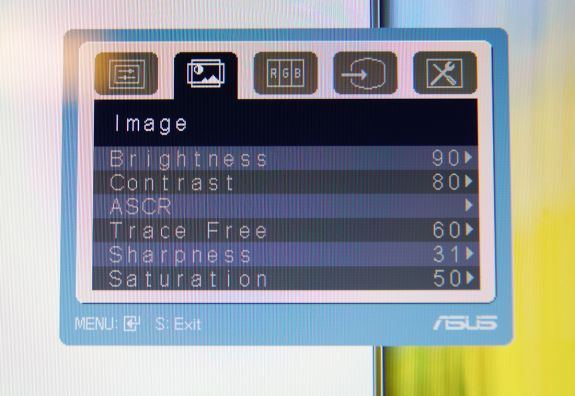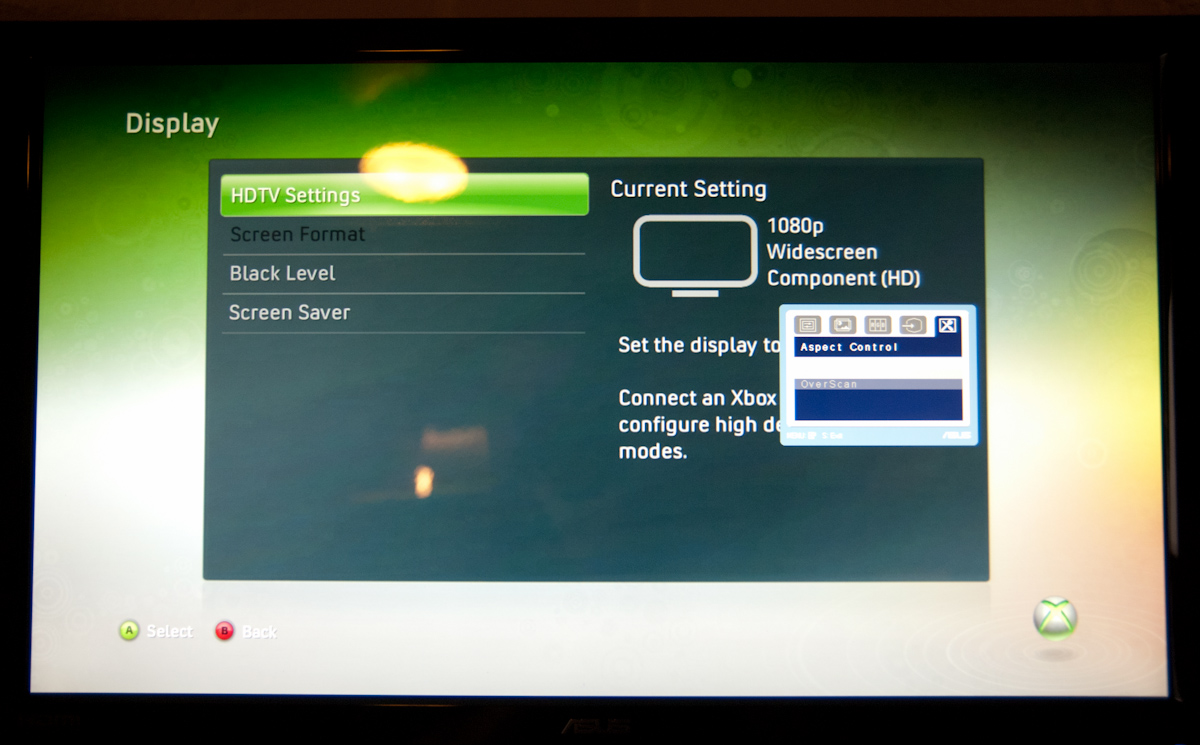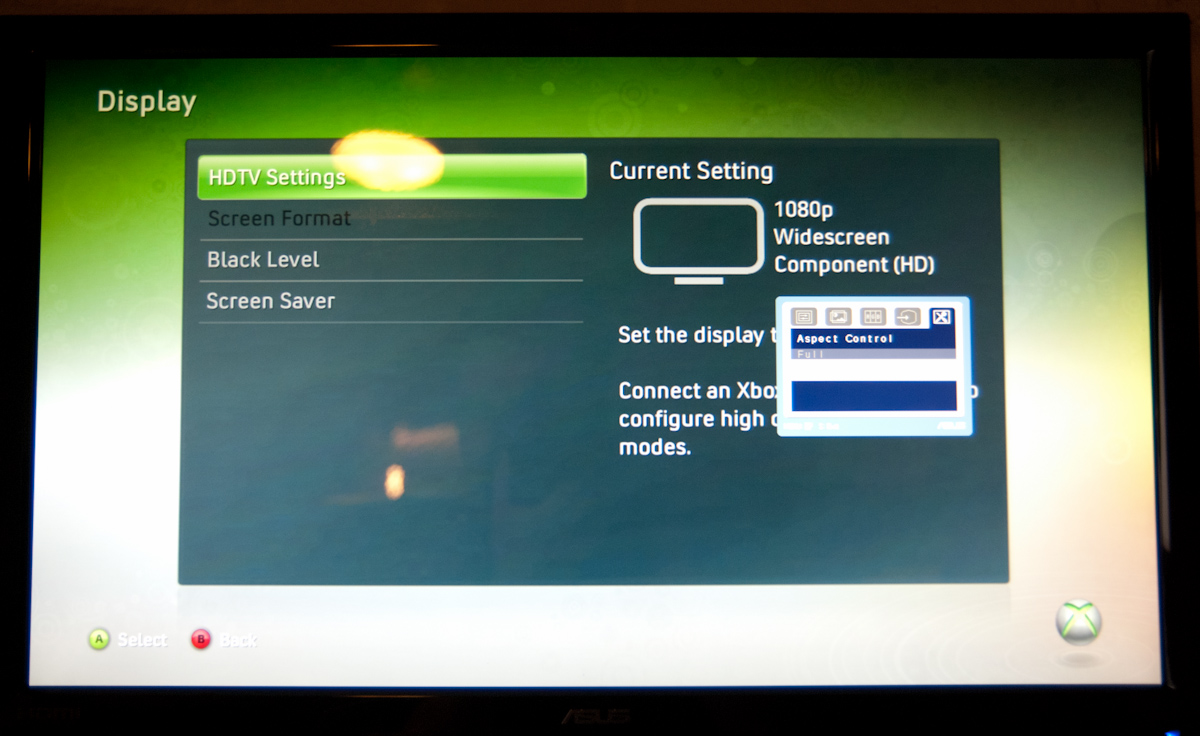ASUS VG236H 23-inch 3D Display Review: 120Hz is the Future
by Brian Klug on August 7, 2010 2:48 AM ESTOSD Controls
The front of the display is glossy, but tasteful. There’s the ASUS logo front and center, a subtle HDMI logo silkscreened in the bottom left, and on the bottom right are the OSD control buttons. To the right of the rightmost button is a blue power LED.
I guess these buttons are my second and last major complaint about the VG236H. There are 6 buttons, and while they work just fine and the control schema itself is straightforward, the problem is just how hard to see they are. The symbols are screened onto the plastic, and are just too hard to see.
The other problem is that there aren’t any raised edges or bits on them, so it’s hard to know when you’re actually pressing the center of a button. Most of the time, I just counted gaps to tell which button I was on. The power button has a small red line which differentiates it, but the rest are all the same and are just a bit difficult to use. There’s also a bit of flex in the whole display arm when pressing these buttons.
There’s a dedicated source button, menu button, and ‘splendid’ display mode button which cycles through five presets. The up and down buttons change brightness and contrast when the menu isn’t up. Tap down, and you can change contrast. Tap up, and you can change brightness. After tapping and entering respective modes, you can adjust in both directions.
I figure we should talk about the OSD controls here, which are actually very good. ASUS exposes different settings in the image tab depending on which spelendid mode you’re using. Under Standard, you’ll only be given brightness, contrast, and trace free - which lets you directly control LCD Overdrive. You can change ‘Trace Free’ in increments of 20, from 0 to 100.
Change modes to ‘Game’, and you can change brightness, contrast, ASCR (dynamic contrast), trace free, sharpness, and saturation. In fact, all of the modes except Standard seem to expose all the settings, which is interesting.
When you’re in 3D mode, the OSD also locks down into predefined settings for optimal 3D quality. In fact, all you’re left able to control is contrast. I can understand this - when doing things in 3D, you’re going to want all the brightness the panel can deliver, and probably the most ‘Trace Free’ the display can offer.
ASUS also thankfully provides a variety of OSD aspect ratio controls. You can select from full, 4:3, and overscan. There’s no 1:1 option, but what content seriously isn’t 1080P these days anyways? Full and 4:3 are self explanatory - Full is basically stretch, while 4:3 leaves you with black bars.
Overscan is a bit different, and I’m surprised ASUS included it, but props for doing so. I’d say that overscan is still a misunderstood beast for a lot of the population, but it’s simple - it’s extra image around the viewable image which gets cropped out. Back in the days of CRT TVs (seriously, can you still find a CRT TV at a store anymore?), image placement wasn’t perfect. To ensure uniformity, there was a safe area for content and important information, and a border that would get cut off. If you’ve ever done layout for publishing, think about the bleed area used for trimming, and you’ll get the picture exactly.
You can see the difference between the xbox dashboard with overscan on and off here. Basically, putting the monitor in overscan mode is what you’ll want to do, as you get close to 1:1 reproduction with no cropping. It’s awesome that ASUS included this, even a number of high end TVs have ambiguous or no overscan control, which is annoying.
There’s also our complete OSD tour in the gallery below:
Viewing Angles
Viewing angles on the VG236H are what you’d expect from a TN panel. There isn’t very much contrast or color distortion viewing the display at even extreme horizontal angles, it’s vertical angles that are sensitive to viewing angle. Check out our viewing angle gallery below:
ASUS advertises 170 degrees of viewing angle in the horizontal plane, and 160 degrees in the vertical with a 10:1 contrast ratio. I’d say the vertical angle you get isn’t quite as advertised, but honestly if you’re viewing the monitor from so far down below that this is noticeable, you’re probably doing something wrong and will complain more about damage to your spine than how colors look funny.
I’d say viewing angles overall are pretty standard on the VG236H.


























121 Comments
View All Comments
HDPeeT - Sunday, August 8, 2010 - link
120hz HDTVs have more input lag because they don't actually accept 120hz input signals but instead interpolate frames from a 60hz or 24hz signal. This of course takes a considerable amount of time since the display has to analyze several frames before it can create the interpolated frames. 120hz/3D monitors such as this one actually accept a true 120hz signal from your video card, so there is no need to create additional ones through interpolation. All things being equal, a monitor that is receiving 120fps SHOULD have LESS lag than one that is only receiving 60fps. Of course all things might NOT be equal here, as the display might have more processing than some of the faster 60hz monitors out there.Like you, I also don't understand how they came up with the 3.9ms figure............he did say that the Asus was "consistently" 1 frame behind the other LCD, which would mean it has at LEAST 8ms of input lag.
DarkUltra - Sunday, August 8, 2010 - link
The DVI link tech is not buffering or packadge based. It transfers all three colors, one pixel at a tiime. Fortunately, LCD can have zero input lag (compared to a CRT). Overdrive is not really a digital processing job, like say interpolation or scaling. It just gives the crystals an initial volt bump, then lowers the volt to normal levels. This is so the crystals turn faster.http://www.digitalversus.com/duels.php?ty=6&ma...
However, input lag should be measured on the same output.
testing with two displays connected to the two outputs of a video card and using a clone mode does not give accurate results – they simply vary too much! So in order to compare displays and have an accurate judgment on the presence or lack of input lag you must use a passive video splitter that is capable of splitting a single video signal to two displays.
http://3dvision-blog.com/viewsonic-vx2268wm-has-ju...
nvmarino - Sunday, August 8, 2010 - link
Great news! Thanks for the extra effort!Stokestack - Sunday, August 8, 2010 - link
"and I’ve yet to see passive polarization methods used outside the movie theatre"They exist. At SIGGRAPH at least two years ago, someone (I think it was JVC) demoed a 3-D monitor that had every other horizontal line polarized in the opposite direction. Not a bad choice; you got half vertical resolution, but full horizontal resolution.
DarkUltra - Sunday, August 8, 2010 - link
Is there a white halo effect around text and graphics in 2D "desktop" use like the Acer GD245HQ? Is there a sharpening effect? Can it be adjusted?http://img179.imageshack.us/img179/3688/acergd245h...
dgz - Monday, August 9, 2010 - link
"The necessity for 120Hz panels arose entirely out of the ongoing 3D obsession" is plain wrong.Quake should be played at 120Hz as all other frantic FPS games. For CoD kids 60Hz and "3D" may be fine, though.
dgz - Monday, August 9, 2010 - link
Good ol' CRTs, how I miss you :(dgz - Monday, August 9, 2010 - link
Just asking.Zap - Monday, August 9, 2010 - link
Regarding polarized 3D mentioned in the article, IZ3D has brought polarized 3D tech (using cheap polarized glasses) to gamers for several years. Just wanted to throw that out there.zoxo - Monday, August 9, 2010 - link
I think every 3D technology that uses active glasses is garbage. Manufacturers need to create circularly polarized monitors before it is really usable.